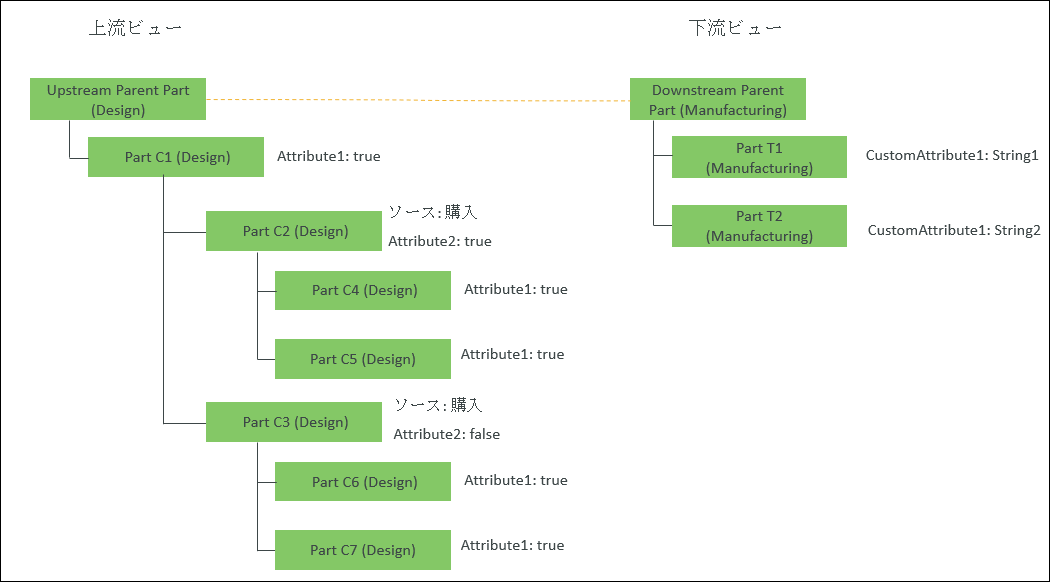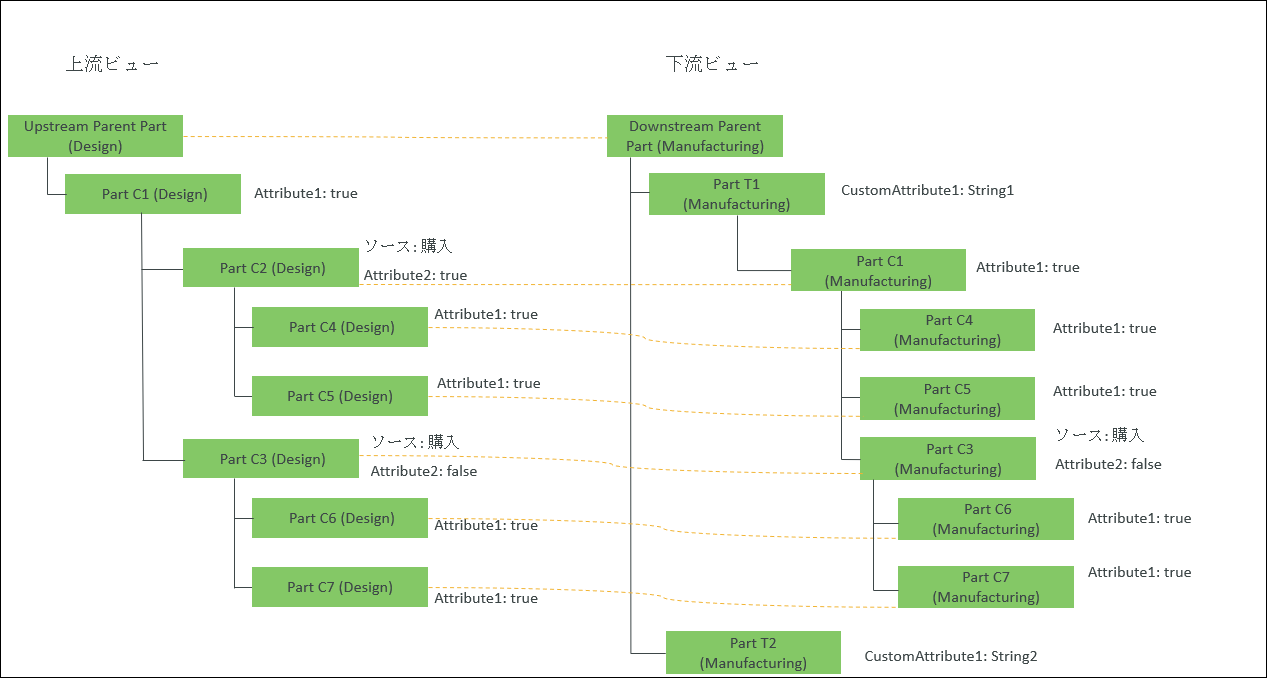ユースケース 9: 2 つの属性に基づいて部品をスキップして下流構造を生成
BOM トランスフォーマに以下の構造が存在するとします。

• Upstream Parent Part (Design) と Downstream Parent Part (Manufacturing) の間に対応リンクが存在します。
• Part C1 (Design)、Part C4 (Design)、Part C5 (Design)、Part C6 (Design)、および Part C7 (Design) の部品親子関係属性 Attribute1 が true に設定されています。
Attribute1 はブール型の属性です。Windchill では、この属性の値は Yes と No です。true および false はそれぞれ Yes および No と同義です。 |
• 構造内のすべての部品の部品タイプは wt.part.WTPart です。
2 つの属性に基づいて部品をスキップして下流構造を生成するには、規則ファイルまたはプロパティファイルを使用して変換規則と再構築規則を指定できます。
規則ファイルを使用
{
"transformRules": [
{
"sourceType": "wt.part.WTPart",
"newAttributeMappings": [
[
"source.usage.Attribute1:true",
"target.part.CustomAttribute1:String1",
"doAndValidationForAttr": "true"
]
],
"targetType": "wt.part.WTPart",
"transformOption": "newPart",
"skipAttributes":
[
"source:buy",
"Attribute2":"true"
]
}
]
}
"transformRules": [
{
"sourceType": "wt.part.WTPart",
"newAttributeMappings": [
[
"source.usage.Attribute1:true",
"target.part.CustomAttribute1:String1",
"doAndValidationForAttr": "true"
]
],
"targetType": "wt.part.WTPart",
"transformOption": "newPart",
"skipAttributes":
[
"source:buy",
"Attribute2":"true"
]
}
]
}
プロパティファイルを使用
1. Windchill/codebase/com/ptc/core/foundation/associativity にあるファイル associativity.properties.xconf にアクセスします。
2. Windchill/codebase/com/ptc/core/foundation/associativity ファイルに以下の再構築規則を追加します。
<Property name="com.ptc.windchill.associativity.reconciliation.addusage.wt.part.WTPart" multivalued="," default=""/>
<AddToProperty name="com.ptc.windchill.associativity.reconciliation.addusage.wt.part.WTPart" value="transformOption=newPart"/>
<AddToProperty name="com.ptc.windchill.associativity.reconciliation.addusage.wt.part.WTPart" value="targetType=wt.part.WTPart"/>
<AddToProperty name="com.ptc.windchill.associativity.reconciliation.addusage.wt.part.WTPart" value="attributeMapping.rule1=Attribute1:true:CustomAttribute1:String1"/>
<AddToProperty name="com.ptc.windchill.associativity.reconciliation.addusage.wt.part.WTPart" value="skipAttribute.Source=buy"/>
<AddToProperty name="com.ptc.windchill.associativity.reconciliation.addusage.wt.part.WTPart" value="skipAttribute.Attribute2=true"/>
<AddToProperty name="com.ptc.windchill.associativity.reconciliation.addusage.wt.part.WTPart" value="doAndValidationForAttr=true"/>
上流で選択した部品に対して  操作を開始すると、選択した部品の下の構造がスキャンされます。このコンフィギュレーションによって以下の処理が行われます。
操作を開始すると、選択した部品の下の構造がスキャンされます。このコンフィギュレーションによって以下の処理が行われます。
 操作を開始すると、選択した部品の下の構造がスキャンされます。このコンフィギュレーションによって以下の処理が行われます。
操作を開始すると、選択した部品の下の構造がスキャンされます。このコンフィギュレーションによって以下の処理が行われます。• 部品属性 Attribute1 が true に設定されている部品が上流で検出された場合、その部品は、下流の、属性 CustomAttribute1 が String1 に設定されている部品の下に変換されます。これは新規部品として変換されます。
• 部品属性 Attribute2 が true に設定され、属性 Source が buy に設定されている部品が上流で検出された場合、その部品はスキップされ、下流には追加されません。ただし、検出された部品の下の構造はスキャンされます。
BOM トランスフォーマに以下の構造が表示されます。

• Part C2 (Design) は、指定されている次の基準を満たすので、スキップされます。
◦ <AddToProperty name="com.ptc.windchill.associativity.reconciliation.addusage.wt.part.WTPart" value="skipAttribute.Source=buy"/>
◦ <AddToProperty name="com.ptc.windchill.associativity.reconciliation.addusage.wt.part.WTPart" value="skipAttribute.Attribute2=true"/>
◦ <AddToProperty name="com.ptc.windchill.associativity.reconciliation.addusage.wt.part.WTPart" value="doAndValidationForAttr=true"/>
ただし、その下の構造はスキャンされます。
• Part C1 (Design)、Part C4 (Design)、Part C5 (Design)、Part C6 (Design)、および Part C7 (Design) の部品属性 Attribute1 が true に設定されています。したがって、これらは Part T1 (Manufacturing) の下に新規部品として追加されます。Part T1 (Manufacturing) の部品属性 CustomAttribute1 が String1 に設定されています。
• Part T2 (Manufacturing) の下に部品は追加されません。これは、その部品属性 CustomAttribute1 が String2 に設定されているためです。